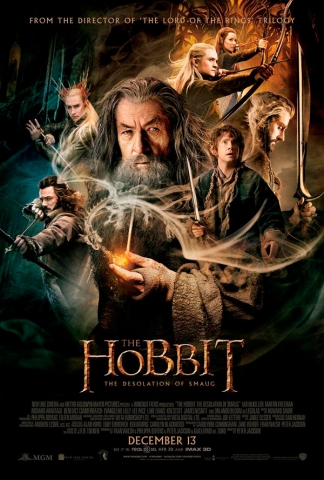Hobbits in HFR
Personal experience of the 48fps high frame rate.
Date: Monday 16th, December, 2013
On Saturday I sat through my first experience of the new 48 frames per second high frame rate (HFR) projection in "The Hobbit: The Desolation of Smaug" and was deeply disappointed.
I know I'm not the only one to have felt this way, from the many reviews and reports in recent days and similar responses to last year's release of the first Hobbit film, but I thought I'd lay down my experiences.
HFR and "Reality"
48fps HFR projects a film at twice the frame rate of other films for the last century. The normal rate we're accustomed to is 24fps and doubling it is said to reproduce imagery closer to the rate the human eye perceives the world. This is supposed to make images appear clearer and far more realistic for the viewer. The problem as I saw it on Saturday was that the rest of the production technology hasn't kept up with the improved definition.
This looks more like a throwback to the times in the 1980s when digital production first appeared on TV and the sharp clarity or imagery made everything look "unreal".
Sharper Imagery cuts through the Magic of Illusion
HFR has a similar problem to early digital production - it highlights everything, the lighting, the depth of field, costumes, sets are all brought into pin-point detail. Any lack of reality, any fakery, any stage tricks or misdirections are thrown into the light for everyone to see.
What is supposed to be a small town on a lake is shown up for a series of props in a studio and any sense that we're in the real world is thrown off by every lighting angle throwing up sharp reliefs everywhere, shattering any practical illusion of exterior location.
A meeting in the first scenes of the film set in a small inn looks like it was set in a TV studio some time in a 1980s production, a cheap studio that lacked any "real" atmosphere under its cruel lighting and definition of detail. I expected the sets to wobble at any moment.
This issue appeared throughout the film, making it a distraction in almost every scene.
Cross-Eyed in 3D Special Effects
Add 3D imagery and special effects and another problem arises - you can see the join.
There were many scenes and moments in this film when an effect was overlain, or 3D applied that threw my eyes out of focus. Digital effects that were supposed to overlay the scene appeared almost in double-vision and outlines of live action characters occasionally appeared transparent, or were seen through transparent edges where the two elements met. It's a trick you miss in regular definition frame rates, but here the technical trickery is really highlighted to distracting ill effect.
At some moments in the film I had to give up and close one eye just to cut the effect off completely.
Real Scenery in a Magical World, and Focal Depth
A few moments in the film took advantage of the magnificent scenery of New Zealand and certainly showed a depth of detail you'd not have seen before, but I wonder how much this was really necessary when a story like The Hobbit relies on creating a magical, mystical world, an age when everything should glow with magic or be shrouded in the mists of distance and time. Here it was too "normal" to convey a sense of wonder and magic that ought to pervade every frame.
There is another aspect here. Often in our own perception of the world there is a focal mist, a falling off of focal acuracy through distance. This is a combination of the air's own mist (doesn't apply in space if you're thinking of a Sci-Fi film in the future) which adds a faint diffusion of detail through distance in the "mist" to the horizon, and the natural de-focus we all have when watching something closely, we tend to focus on the subject in-hand and not the surrounding background.
In a number of cases in the film this didn't occur, the photographer's focus on the foreground, and we have everything in precise detail overwhelming the characters and their action as they become lost in the scenery. It only occured one or twice in the film but became another distraction. I guess we have to learn to live with this and focus ourselves in the future should this effectivness of detail become common.
Conclusion and the future of HFR
The magic of film is to cast a spell over the audience and send them into a world of their dreams. Creating such a magical world takes work and patience and perhaps the use of "realism" is inappropriate on such a journey?
At this stage HFR is an interesting experiment, but not one to pursue alone. If the technology is to be adopted effectively on a larger scale a comparable attention to detail is critical in all elements of the production, lighting, sets, props, costumes and special effects.
Without this attention to detail we will remain in that oddly sharp and unmagical world, that is a digital production, more like a video documentary being shot behind the scenes or a preprocessed early draft of the film before it goes to post-production.
I believe it will take more money, time and effort to master the new arts and return the magic of the movies in HFR. Whether or not it will be worthwhile only time and effort will tell.

